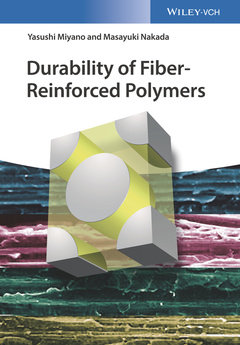Description
Durability of Fiber-Reinforced Polymers
Authors: Miyano Yasushi, Nakada Masayuki
Language: English
Subject for Durability of Fiber-Reinforced Polymers:
Keywords
durability of fiber-reinforced polymers
140.84 €
In Print (Delivery period: 14 days).
Add to cart192 p. · 17.5x24.9 cm · Hardback
Description
/li>Contents
/li>Biography
/li>
After a short introduction to the viscoelastic behavior of fiber-reinforced plastics, the text goes on to review in detail the concepts of static, fatigue and creep strengths in polymer composites. An application-oriented approach is adopted such that the concepts developed in the book are applied to real-life examples.
Indispensable information for materials scientists and engineers working in those industrial sectors is concerned with the development and safe use of polymer composite-based products.
Preface ix
1 Introduction 1
2 Viscoelasticity 5
2.1 Introduction 5
2.2 Concept of Viscoelastic Behavior 5
2.3 Concept of Time–Temperature Superposition Principle (TTSP) 7
2.4 Master Curve of Creep Compliance of Matrix Resin 8
2.5 Generalization of TTSP for Nondestructive Deformation Properties to Static, Creep, and Fatigue Strengths of FRPs 9
2.6 Master Curve of Static Strength of FRP 11
2.7 Master Curve of Creep Strength of FRP 12
2.8 Master Curve of Fatigue Strength of FRP 13
2.9 Conclusion 15
Reference 15
3 Master Curves of Viscoelastic Coefficients of Matrix Resin 17
3.1 Introduction 17
3.2 Master Curve of Creep Compliance Based on Modified TTSP 17
3.2.1 Experimental Procedures 19
3.2.2 Reliable Long-Term Creep Compliance of Matrix Resin 20
3.3 Simplified Determination of Long-Term Viscoelastic Behavior 22
3.3.1 Relation between Storage Modulus and Creep Compliance 24
3.3.2 Formulation of Master Curves of Creep Compliance 24
3.3.3 TTSP Automatic Shifting Procedure 26
3.3.4 Experimental Procedures 26
3.3.5 Master Curve of Storage Modulus by DMA 26
3.3.6 Comparison of Master Curves of Creep Compliance 29
3.4 Conclusion 30
References 32
4 Nondestructive Mechanical Properties of FRP 33
4.1 Introduction 33
4.2 Role of Mixture 33
4.3 Mechanical and Thermal Properties of Unidirectional CFRPs, Fibers, and Matrix Resin 35
4.4 Master Curves of Creep Compliance of Matrix Resin 35
4.5 Conclusion 36
References 37
5 Static and Fatigue Strengths of FRP 39
5.1 Introduction 39
5.2 Experimental Procedures 39
5.2.1 Preparation of Specimens 39
5.2.2 Test Procedures 40
5.3 Results and Discussion 42
5.3.1 Master Curve of Static Strength 42
5.3.2 Master Curve of Fatigue Strength 44
5.3.3 Characterization of Fatigue Strength for Loading Directions of Three Kinds 45
5.4 Applicability of TTSP 51
5.5 Conclusion 52
References 53
6 Formulation of Static Strength of FRP 55
6.1 Introduction 55
6.2 Formulation of Static Strength 55
6.3 Application of Formulation 57
6.3.1 Experimental Procedures 57
6.3.2 Preparation of Specimens 57
6.3.3 Test Procedures 58
6.4 Results and Discussion 60
6.4.1 Master Curve of Creep Compliance for Matrix Resin 60
6.4.2 Master Curve of Tensile Static Strength for Matrix Resin 62
6.4.3 Master Curves ofThree Kinds of Static Strengths of Unidirectional CFRP 64
6.5 Conclusion 69
References 69
7 Formulation of Fatigue Strength of FRP 71
7.1 Introduction 71
7.2 Formulation 71
7.3 Application of Formulation 72
7.3.1 Specimens and Test Methods 72
7.3.2 Creep Compliance of Matrix Resin 73
7.3.3 Master Curves of Static and Fatigue Strengths for Unidirectional CFRP 74
7.4 Conclusion 81
References 82
8 Formulation of Creep Strength of FRP 83
8.1 Introduction 83
8.2 Formulation 83
8.3 Application of Formulation 85
8.3.1 Specimens and Test Methods 86
8.3.2 Creep Compliance of Matrix Resin and Static Strength of CFRP Strand 86
8.3.3 Creep Failure Time of CFRP Strand 88
8.4 Conclusion 90
References 90
9 Application 1: Static Strengths in Various Load Directions of Unidirectional CFRP UnderWaterAbsorption Condition 91
9.1 Introduction 91
9.2 Experimental Procedures 91
9.3 Viscoelastic Behavior of Matrix Resin 92
9.4 Master Curves of Static Strengths for Unidirectional CFRP 96
9.5 Relation between Static Strengths and Viscoelasticity of Matrix Resin 99
9.6 Conclusion 100
References 100
10 Application 2: Static and Fatigue Flexural Strengths of Various FRP Laminates UnderWater Absorption Condition 101
10.1 Introduction 101
10.2 Specimen Preparation 101
10.3 Experimental Procedures 104
10.4 Creep Compliance 105
10.5 Flexural Static Strength 107
10.6 Flexural Fatigue Strength 109
10.7 Conclusion 121
References 122
11 Application 3: Life Prediction of CFRP/Metal Bolted Joint 123
11.1 Introduction 123
11.2 Experimental Procedures 123
11.2.1 Preparation of CFRP/Metal Bolted Joints 123
11.2.2 Tensile Static and Fatigue Tests 125
11.3 Results and Discussion 126
11.3.1 Master Curves of Creep Compliance for Transverse Direction of
Unidirectional CFRP Laminates 126
11.3.2 Load–Elongation Curves at Tensile Static Tests for CFRP/Metal Bolted Joint 128
11.3.3 Master Curves of Static Failure Load for CFRP/Metal Bolted Joint 130
11.3.4 Master Curves of Fatigue Failure Load for CFRP/Metal Bolted Joint 131
11.3.5 Fracture Appearance of CFRP/Metal Bolted Joints Under Static and Fatigue Loadings 135
11.4 Conclusion 138
References 139
12 Application 4: Life Prediction of CFRP Structures Based on MMF/ATMMethod 141
12.1 Introduction 141
12.2 Procedure of MMF/ATM Method 142
12.3 Determination of MMF/ATM Critical Parameters 143
12.3.1 Long-Term Static and Fatigue Strengths of Unidirectional CFRP 143
12.3.2 MMF/ATM Critical Parameters of Unidirectional CFRP 144
12.4 Life Determination of CFRP Structures Based on MMF/ATM Method 144
12.5 Experimental Confirmation for OHC Static and Fatigue Strengths of CFRP QIL 148
12.6 Conclusion 151
References 151
A Effect of Physical Aging on the Creep Deformation of an Epoxy Resin 153
A.1 Introduction 153
A.2 Creep Deformation for Aged Polymers 153
A.3 Experimental Procedure 156
A.4 Results and Discussion 157
A.4.1 Creep Compliance 157
A.4.2 Effect of Physical Aging on Creep Compliance 159
A.5 Conclusions 162
References 162
B Reliable TestMethod for Tensile Strength in Longitudinal Direction of Unidirectional CFRP 165
B.1 Introduction 165
B.2 Evaluation of Tensile Strength Using Post-Bonded CFRP Strand Specimen 166
B.3 Development of Co-Cured CFRP Strand Specimen 169
B.3.1 Molding of Co-Cured CFRP Strand Specimen 169
B.3.2 Improvement of Co-Cured CFRP Strand Specimen 169
B.4 Conclusions 174
References 174
Index 177




